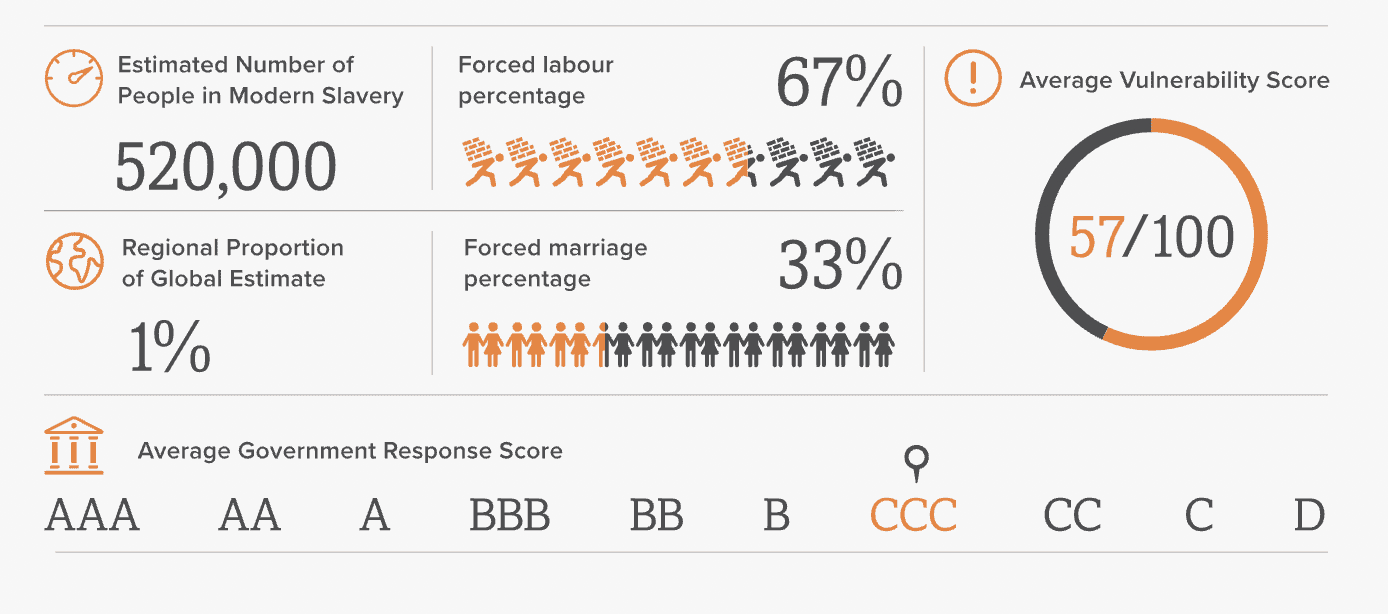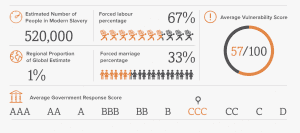
Regional Analysis: Arab States

The Arab States region covers 11 countries including Bahrain, Iraq, Jordan, Kuwait, Lebanon, Oman, Qatar, Saudi Arabia, Syria, United Arab Emirates and Yemen, and is home to two percent of the world’s population. The region is diverse, spanning the wealthier Gulf Cooperation Council (GCC countries) and countries such as Jordan, Lebanon, and Iraq, which are dealing with the impact of ongoing conflict in Syria. This regional study summarises a longer set of findings, which can be found in the Global Slavery Index: Arab States Report.
PREVALENCE WITHIN THE ARAB STATES
On any given day in 2016, an estimated 520,000 men, women, and children were living in modern slavery in the Arab States. This is a prevalence of 3.3 victims per 1,000 persons. When considering the forms of modern slavery, the largest share of those in modern slavery were victims of forced labour (2.2 victims per 1,000 people), while the rate of forced marriage was 1.1 victims per 1,000 people.
Over half of all victims of forced labour exploitation (51 percent) were held in debt bondage and this affected a greater share of female victims than male victims. The Arab States accounted for one percent of victims of forced sexual exploitation globally.
Within the region, Syria, Iraq, and Yemen had both the highest prevalence of modern slavery and the highest absolute number of victims, accounting for 76 percent of the victims in the region.
These regional figures, while important, should be interpreted cautiously given the gaps and limitations of data in this region. Only two national surveys were conducted in the Arab States region (Lebanon and Jordan), both conducted in Arabic, and none were conducted in the Gulf Cooperation Council (GCC) states, despite the incidence of forced labour reported by various sources in such sectors as domestic work and construction in the GCC countries. The regional estimates for the Arab States were therefore built mainly from respondents who were interviewed in their country of residence and reported about their forced labour situation while working in that region. Further, measurement of forced marriage among residents of countries within the region is particularly problematic where there are no surveys. Taken together, these gaps point to the likelihood of a significant underestimation of the extent of modern slavery in this region.
Similarly, as it is typically not possible to survey in countries that are experiencing profound and current conflict, such as Syria, Iraq, and Yemen, data from these states are likely to understate the problem.1
Table 1 Estimated prevalence of modern slavery by country, Arab States2
| Rank | Country | Estimated prevalence (victims per 1,000 population) | Estimated absolute number of victims | Population |
|---|---|---|---|---|
| 1 | Syrian Arab Republic* | 7.3 | 136,000 | 18,735,000 |
| 2 | Iraq* | 4.8 | 174,000 | 36,116,000 |
| 3 | Yemen* | 3.1 | 85,000 | 26,916,000 |
| 4 | Oman* | 2.1 | 9,000 | 4,200,000 |
| 5 | Saudi Arabia* | 1.9 | 61,000 | 31,557,000 |
| 6 | Bahrain* | 1.9 | 3,000 | 1,372,000 |
| 7 | Jordan* | 1.8 | 17,000 | 9,159,000 |
| 8 | Lebanon* | 1.7 | 10,000 | 5,851,000 |
| 9 | United Arab Emirates* | 1.7 | 15,000 | 9,154,000 |
| 10 | Qatar* | 1.5 | 4,000 | 2,482,000 |
| 11 | Kuwait* | 1.5 | 6,000 | 3,936,000 |
*Substantial gaps in data exist for the Arab States region and Gulf countries in particular. These gaps point to a significant underestimate of the extent of modern slavery in this region. As a result, the country-level estimates presented here are considered very conservative and should be interpreted cautiously.
VULNERABILITY WITHIN THE ARAB STATES
Figure 1 Regional average vulnerability scores by dimension, Arab States
A regional analysis of our vulnerability measures suggests higher risk of modern slavery in the Arab States than is evident in the prevalence data, with the Arab States rating as the second most vulnerable region (57 percent). The Arab States region performed relatively well on the nourishment and access dimension of the vulnerability model, but relatively poorly on the governance and effects of conflict dimensions (Figure 1). The regional score in the conflict dimension hides diversity within the region, with some countries such as Yemen, Syria, and Iraq scoring much higher on this dimension than other countries in the region. The regional average on measures of inequality points to slightly higher vulnerability than the global average on this dimension (41 percent cf 38 percent) and, again, there is a great deal of diversity within the region, with scores ranging from a low of 25 percent in UAE to a high of 65 percent in Iraq. Across all dimensions of vulnerability, the highest score was found in Syria (92 percent).
Table 2 Estimated vulnerability to modern slavery by country, Arab States
| Country Name | Governance issues | Lack of basic needs | Inequality | Disenfranchised | Effects of conflict | Weighted overall average |
|---|---|---|---|---|---|---|
| Syrian Arab Republic | 85.6 | 36.9 | 62.5 | 33.4 | 95.4 | 92.3 |
| Yemen | 79.2 | 43.1 | 49.2 | 53.0 | 69.9 | 86.4 |
| Iraq | 72.6 | 34.9 | 65.2 | 46.6 | 89.4 | 85.7 |
| Lebanon | 59.1 | 22.6 | 48.1 | 44.8 | 47.8 | 58.9 |
| Oman | 68.7 | 20.5 | 37.8 | 33.4 | 6.4 | 50.1 |
| Jordan | 57.9 | 15.7 | 41.8 | 47.4 | 26.2 | 49.9 |
| Bahrain | 63.0 | 25.8 | 34.5 | 24.0 | 25.4 | 49.6 |
| Saudi Arabia | 63.2 | 21.9 | 30.1 | 14.2 | 32.2 | 46.3 |
| Kuwait | 59.7 | 20.1 | 29.3 | 29.3 | 28.5 | 45.9 |
| Qatar | 56.3 | 13.8 | 29.5 | 33.4 | 7.0 | 37.7 |
| United Arab Emirates | 47.9 | 15.1 | 24.7 | 7.8 | 11.9 | 26.8 |
GOVERNMENT RESPONSES WITHIN THE ARAB STATES
The Arab States region scores an average CCC rating on government response. This is despite its relatively high GDP (PPP) per capita in the GCC countries. As a wealthy subregion, the GCC States average CCC rating reveals limited protections for migrant populations most vulnerable to modern slavery. Unlike Asia Pacific (also averaging CCC), the more stable governments in this region which might be expected to act, have taken very few steps to protect the rights and safety of the millions of migrant workers who make up their construction and domestic work sectors. Other countries in the region, such as Jordan and Lebanon, have put in place some protections for migrant populations, but struggle to deal with ongoing conflict in Syria and Yemen, and the flow of people fleeing these crises.
Table 3 Movements in government response rating for the Arab States 2016 to 2018
| Country | 2016 Rating | Change in rating | 2018 Rating |
|---|---|---|---|
| United Arab Emirates | B | B | |
| Jordan | B | CCC | |
| Qatar | CCC | CCC | |
| Bahrain | CCC | CCC | |
| Oman | CCC | CCC | |
| Lebanon | CCC | CCC | |
| Saudi Arabia | CC | CC | |
| Kuwait | CC | CC |
*Countries that scored -1 on a negative indicator could not score above a BBB rating
**Not rated in 2016 Global Slavery Index
***Included for the first time in 2018, therefore a rating is not provided.
All data are still available via the Global Slavery Index website
Table 4 Government response rating, milestone percentage, and total score by country, Arab States
| Rating | Country | Support survivors | Criminal justice | Coordination | Address risk | Supply chains | TOTAL |
|---|---|---|---|---|---|---|---|
| B | United Arab Emirates | 63.0 | 41.1 | 56.3 | 42.9 | 0.0 | 47.8 |
| CCC | Jordan | 48.1 | 42.8 | 31.3 | 38.1 | 0.0 | 38.6 |
| CCC | Qatar | 53.0 | 31.7 | 31.3 | 42.9 | 0.0 | 35.4 |
| CCC | Bahrain | 55.2 | 37.2 | 18.8 | 31.0 | 0.0 | 32.6 |
| CCC | Oman | 32.4 | 22.8 | 12.5 | 59.5 | 0.0 | 32.0 |
| CCC | Lebanon | 33.9 | 30.0 | 31.3 | 38.1 | 0.0 | 31.3 |
| CC | Saudi Arabia | 32.4 | 42.8 | 37.5 | 26.2 | 0.0 | 27.9 |
| CC | Kuwait | 28.7 | 33.9 | 25.0 | 45.2 | 0.0 | 27.8 |
FOOTNOTES
Read more here.

